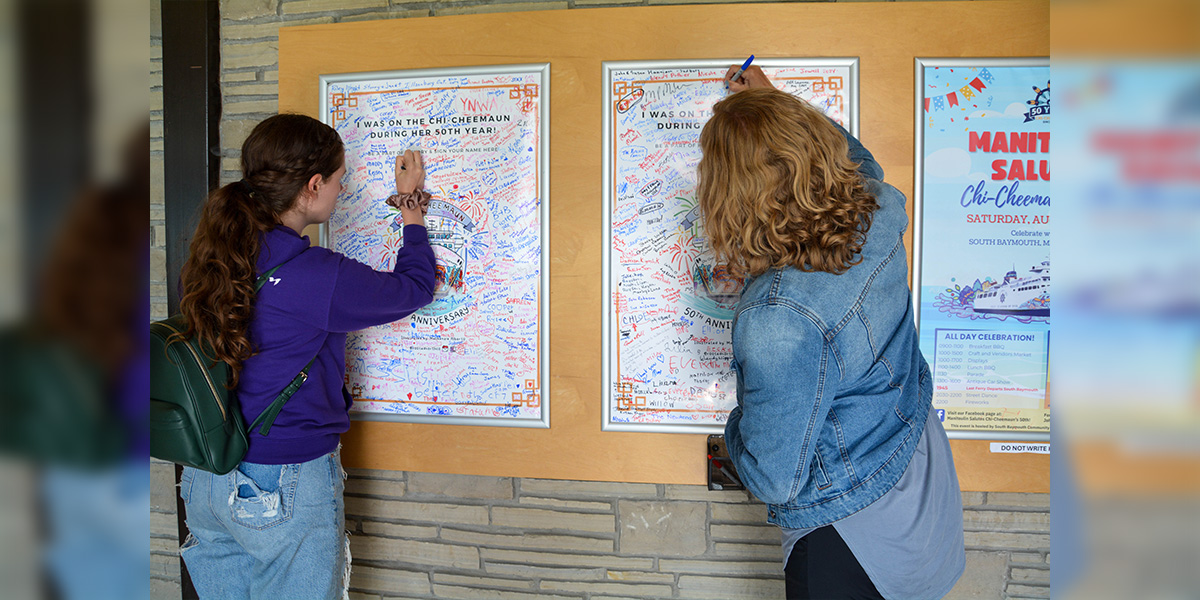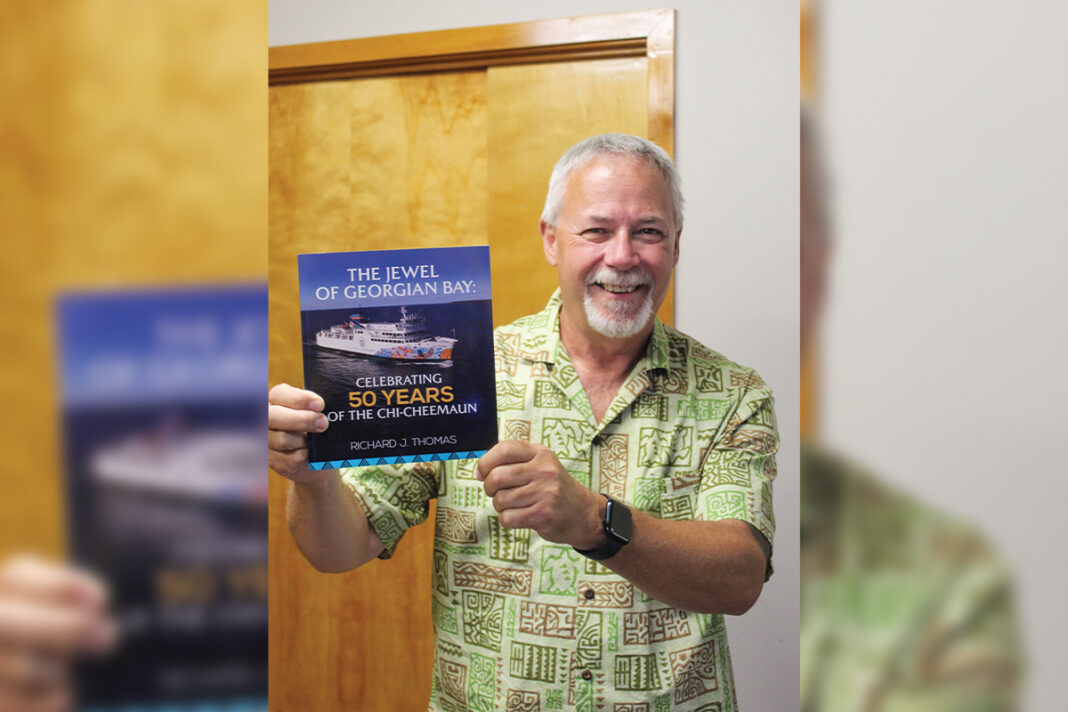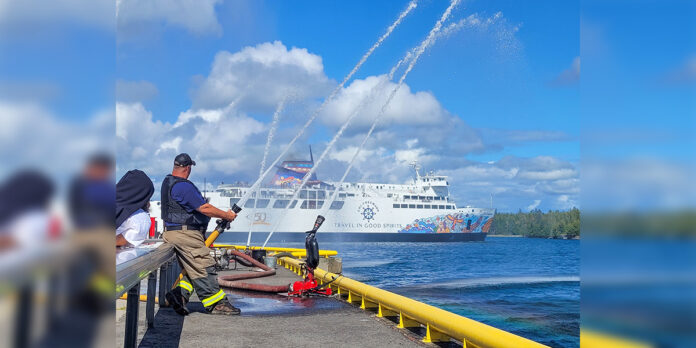KAGAWONG—The MS Chi-Cheemaun provides critical commercial traffic transportation of goods and passengers to and from Tobermory and South Baymouth and the southern and northern part of the province of Ontario, but it has become much more to its passengers and those who have worked for and on the vessel. And after its 50 years with approximately 24,000 voyages, 10 million passengers and three million vehicles having crossed, one thing is very clear.
“People love the Chi-Cheemaun,” stated author Richard Thomas, of Owen Sound, who wrote the recently released ‘The Jewel of Georgian Bay: Celebrating 50 Years of the Chi-Cheemaun.’
“It has to be one if not the most beloved vehicle on the Great Lakes,” stated Mr. Thomas at a presentation he made at ‘History Day in Kagawong’ August 8, put on by the Old Mill Heritage Centre Museum.

And oh, the stories the Chi-Cheemaun could tell—tales of love, heartbreak, funny animal stories and stories of the many weather-related storms the ship has managed to get through over the years.
Mr. Thomas recounted one of the remarkable stories during his presentation. “Dr. Brian Taylor of Lion’s Head shared a story that reads like a movie-of the week plot. ‘Two years ago, my grandson and his girlfriend took the Chi-Cheemaun to Manitoulin to visit his girlfriend’s grandparents who were camping there. He absolutely loved the ferry trip and his description of the voyage brought back many memories of magical ferry trips and my summers over there as a teenager. To my surprise, he was staying at the same campground where I had been many times 50 years earlier.”
“I texted him and told him about my last summer there at age 19, when I met a pretty girl from Ohio,” recalled Dr. Taylor. “We had a crush on each other after a week and then went our separate ways. We wrote to one another a few times, but never saw each other again. My grandson texted me back and told me he had just been talking with a lady from Ohio who had been coming up there on the ferries to Manitoulin all her life. He said her name was Karla. My heart skipped a beat. Karla was the name of my teenaged crush. I was amazed and stunned, and felt I had to find her.”

“I built up my courage, found her number, and called her,” said Dr. Taylor. “To my delight, she remembered me right away! In fact, she told me I’d stood her up all those years ago by not responding to her last letter. We spent a long time talking and, after many more phone conversations, eventually met in person last year. We had both lost our spouses to illness, and realized we still had many things in common. Last summer we sailed back to Manitoulin together on that magical Ch-Cheemaun. We felt like teenagers again, and still do. That majestic ship and the trip to Manitoulin are indeed symbols of our reunion.”
“I would like to thank all the people who sent in stories and pictures for this book,” said Mr. Thomas. He explained, “Last fall, I was talking to the president of OSTC (Owen Sound Transportation Company) who told me this year was going to be the 50th anniversary of the Chi-Cheemaun. What are we going to do to celebrate it, and I said a book was needed. In the springtime I talked to many people from the Collingwood Shipyards and let members of public know I was looking for stories and photos of their memories and thoughts on the Chi-Cheemaun. I received over 90 letters, journeys of those involved in building, operating and sailing on the Jewel of Georgian Bay.”
The OSTC was started in 1921, formed by a group of Owen Sound businessmen. In 1931 the OSTC applied to the province of Ontario for an exclusive franchise of the Tobermory-South Baymouth ferry service. It was granted for the 1932 season, with the M.S. Normac placed on the ferry run. It could transport 66 passengers and had staterooms for 40; as well it could carry 18 automobiles and 200 tons of freight. Cars were charged $4-$5 each way and passengers paid $2 for a one-way trip, or $3.50 return. Breakfast in the ship’s dining room was 40 cents, lunch and dinner were 50 cents.
It was a huge success, and it wasn’t long until the Normac was not able to cope with the traffic, Mr. Thomas said. And the OSTC had to add other existing vessels to the service, such as the Caribou, the Manitou and Hibou which all served there during the summer.
By the end of World War II, car traffic was increasing while the package freight business was declining. The OSTC was reluctant to continue its package freight and passenger service, which wasn’t making a profit, but people and businesses along the North Shore and Manitoulin Island needed it to continue. The federal government was consulted and it was decided a new ship would be built. The Collingwood Shipyard was once again given the contract to build the new vessel, the Norisle (in 1949) at a cost of $565,000.
Mr. Thomas noted by the end of 1971, the Norisle and Norgoma were making four trips every day as well as an evening sailing, and travellers found themselves with long waits crossing.
Mr. Barnard said at a meeting in 1971 that a ship was needed that could handle about 100 cars per trip and load and unload in about 20 minutes instead of the vessels it had that handled about 40-50 cars and took about an hour to load and unload.
An end-loading ferry would speed up loading and unloading times, carry more cars on a single trip and eliminate wait times. But it was going to be expensive, more than $5 million to build the new vessel. “To replace the Chi-Cheemaun today would cost $50 million,” Mr. Thomas told the audience.
The cost was well beyond what the OSTC could afford and discussions with the federal and provincial government were held. At the start of 1972, the government awarded a one-year contract to the OSTC to operate a summer ferry service, with no mention of solutions to the ongoing problems. However, in June of that year the federal government announced $8.8 million would be spent to improve the dock facilities on both sides of the water and a new ferry able to carry 110 cars would be constructed.
“Collingwood Shipyards won the contract to build the new ship,” said Mr. Thomas. However, early in April the shipyard was hit by a strike which lasted 48 days. “The design for the new ship had been completed by west coast marine architect John Case of Case Existological Laboratories in August 1972.” With a length of 365-and-a-half feet, and a beam of 62.5 feet, the new ferry was designed to handle the worst that Georgian Bay could provide.
The Chi-Cheemaun, named ‘Hull 205’ at the time, came together during the latter half of 1973.
September 29, 1974 marked the first run of the Chi-Cheemaun carrying 140 passengers and 60 vehicles. The ship encountered 14-foot waves on the 28-mile journey and even the most sober skeptics conceded she represented a breakthrough in marine safety as she sailed easily through them, said Mr. Thomas.
“Everyone always had a storm story to tell,” Mr. Thomas quipped.
“We also had a few funny animal stories as well,” said Mr. Thomas “Holly Scott said one time she was racing from Mindemoya to South Baymouth to catch the ferry when she wheeled around a curve to see a mother skunk and four babies in the middle of the road. She sailed over the little family and made it just in time for her sailing. ‘I really didn’t notice that anything was amiss until I slowed to stop at the ticket booth in South Baymoth. The smell of skunk was so strong my eyes began to water, and I felt a foul taste in my mouth. The horror of my situation dawned on me as I saw the open mouth of the Cheech in front of me. What would happen when my car was locked in the confines of the car hold? The ticket clerk questioned the idea of taking my vehicle onboard, but I pleaded that I needed to get across, and hopefully the ship was big enough the smell wouldn’t be noticed. I was wrong about that!’
“The stench of fresh skunk spray filled the Chi-Cheemaun,’ said Ms. Scott. “Folks were not bashful about commenting of the foul odour, but I sat out on the outside deck and didn’t head back to my car until the last minute. The thick smell of skunk wafted up the stairs. The entire hold car was so filled with it that I had no fear anyone would track it down to my car. No doubt the smell lingered for days. So, I apologize to all those whose trip was ruined that day. If it is any consolation the skunk family made it safely across the road.”
Referring back to storm stories passengers have encountered over the years, Mr. Thomas told a couple of humorous ones.
“Ann Kelly of Owen Sound shared a story by her father, captain Osborn Long, master of the Norisle. ‘When anybody saw my dad coming off ship or on ship, they would approach him and remind him they had sailed with him on the roughest voyage the Norisle had ever made. And dad, who was a very gentle person, said to the family, ‘that if all those people were aboard the Norisle on her roughest voyage, she’d never have gotten out of the harbour!’
Chi-Cheemaun is a member of the family for lots of people and has such been a part of many significant events, births, deaths, marriages, anniversaries and more, said Mr. Thomas.
As part of his presentation Mr. Thomas told stories with interviews and pictures of crew members and passengers of the ships that sailed the Turkey Trail of Manitoulin Island including the Hibou, Manitoulin, Manitou, Caribou, Manasoo, Normac and the Norgoma.
EDITOR’S NOTE: See next week’s edition of The Expositor for coverage of the presentation made by Mike Strobel on the fateful story of The Rhu, the cabin cruiser that sank in the North Channel near Kagawong resulting in a tragic loss of life.





